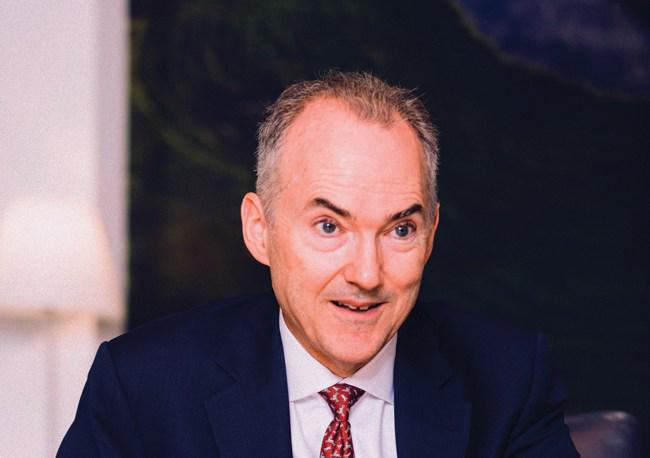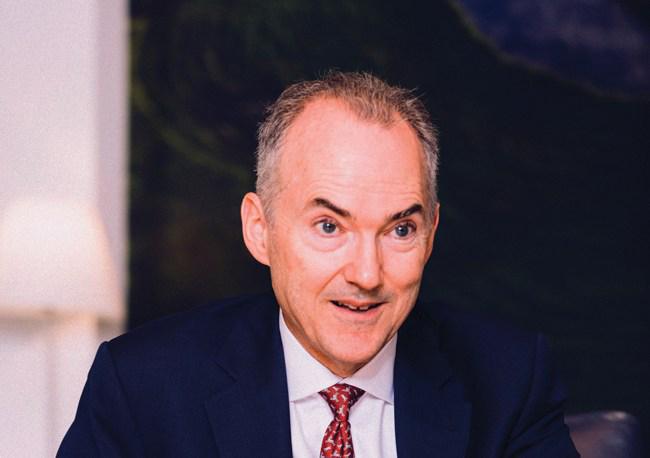Edward Murray, 60, co-founded Allen & Overy (A&O)’s derivatives practice in 1991 while still a senior associate and was until 2013 the senior partner in its derivatives and structured finance group. On 1 October, The Honourable Mr Justice Murray became one of only three solicitors in history to be appointed directly from private practice as a High Court judge. He will sit in the Queen’s Bench Division. We sat down with the City veteran to talk about an unusual journey.
The In-House Lawyer (IHL): It is very rare for solicitors to go straight from private practice to the higher judiciary. How did it happen?
Edward Murray: I did my undergraduate degree in Dublin and liked it there but I was born and raised in the US and thought I could go to New York and be a US attorney. I went to Harvard Law School, with a view to eventually going to London. I graduated from Harvard in 1985 and joined the New York office of Sidley Austin and made it to London in 1987. It was 1990 when I joined A&O.
At Harvard I enjoyed the law and reading cases; I thought idly it would be good to be a judge. You got to apply the law to real facts, not just theoretical situations. Because I was a transactional lawyer, I didn’t think I could do it. I believed all judges were barristers then. As the years went by, I did a lot of advisory work on the risks around these new products. I had to tell clients what I thought an English court or judge would decide on a point of law. Then I thought: ‘I want to be the judge and apply the law in real-world circumstances.’
Becoming a recorder was the logical first step. In 2007 the Judicial Appointments Commission was encouraging solicitors to apply. They asked if they could come into the A&O offices and do a talk. It was a mixed group, mostly litigators. There was a commercial property partner at Linklaters – Alexandra Marks – who became a recorder in 2002. It’s more or less the same authority as a circuit judge. She gave a talk and I was encouraged that she was at a City firm as well.
A former A&O partner, David Mackie (later QC), had also been a recorder while at the firm. He went on to become a full-time circuit judge sitting in the Commercial Court, so I asked him if it made sense for me to become a deputy High Court judge. He hadn’t had any more criminal law experience than I did. In January 2009 I applied to be a recorder. It’s a process that takes several months.
I did three days’ work shadowing in Kingston Crown Court. I also did some informal shadowing with David Mackie in the Commercial Court. As a non-litigator, I lacked the feel for what was going on in court. I sat a qualifying exam at the start of March to get onto the shortlist and at the end of July I was told I was being appointed. In October 2009 I was technically appointed. I did two weeks’ work shadowing and a week-long induction course. I fitted it around my full-time job. In April 2010 I had my first week in court.
IHL: How has your transactional experience been useful in court?
EM: My advisory work helped me in my judicial work – having to draft lengthy memoranda of advice. Also, derivatives touches a lot of different areas of the law – insolvency, trusts, agency and pensions. It is helpful in developing knowledge outside just one area of the law, as most judges have to hear cases outside of their specialisation.
I was first authorised to sit as a deputy High Court judge in September 2013. I sat for the first time that November. As a recorder and a deputy High Court judge, you are basically a locum. You fill in when the judge is away. I have been sitting in the Chancery ever since. I was much less nervous than I expected. In the High Court you don’t have a jury. The Crown Court is more intimidating. You get people charged with more serious offences; you deal with parties from all walks of life. The High Court is less frenetic. In the Crown Court, someone’s liberty or, at least, their reputation is at stake. You need to demonstrate a higher standard of proof.
Initially, every new thing felt like a milestone. The first time I had a request to amend pleadings. The first time I had a request for a summary judgment. The first time I had a proper trial with witnesses. The first time you have to give an ex tempore judgment is daunting; you have to make sure it’s set out properly and reaches the right result. It could still end up in the Court of Appeal. You don’t want to look like an idiot. If you can make the judgment there and then, it’s better for everyone. If you need to think about it, you should always reserve judgment.
IHL: What are the main challenges?
EM: Becoming a full-time judge is primarily a matter of putting in the time and learning the skills. You do two or three training days a year in addition to sitting. There is a monthly newsletter for crime and a quarterly one for civil. You get memoranda on how to deal with different issues like vulnerable witnesses or dealing with the press [laughs]. It all goes towards helping you develop as a full-timer.
I have a number of years’ experience. I had been a High Court judge for four years and a recorder for eight. But I had to overcome the fact I wasn’t an advocate. It’s important for the door to be open to non-advocates but you do need to be aware that you’ve got a bigger hill to climb.
If you join the Queen’s Bench Division, you need experience of criminal trials and get used to dealing with juries. Many litigators don’t even have that much experience of criminal law. Then there’s these 12 cats you’ve got to herd. I don’t mean to be disrespectful – the jury system works well – but a lot of things can go wrong.
IHL: For example?
EM: Maybe a juror has done internet research on a case. Or halfway through the trial someone recognises a key prosecution witness. You have to decide whether they can remain on the case and make sure they don’t contaminate the other jurors. That situation happened to me once. The juror in question only knew the witness tangentially so she was allowed to continue. She said she hadn’t spoken to the other jurors and I had no reason to doubt her.
IHL: What appeals to you about the job?
EM: It might sound corny, but part of it is trying to reach a fair and a just result. Things have to have reached a bad state if you get all the way to court. Sometimes a claimant can’t let go of a perceived injustice, or think they have a strong claim, for example in a family dispute. The resolution of the case can contribute to healing. That can be very satisfying.
In the Crown Court you get some very serious crimes. There may be some powerful mitigation. They might have been brought along by a more influential person, maybe developmental problems have made them vulnerable. You have to weigh that up against the importance of punishment, deterrence and protecting the public. You also need to minimise the risk of the person re-offending. If you come up with the right sentence, you feel you have done some good.
It’s important for the door to be open to non-advocates but you need to be aware you’ve got a bigger hill to climb.
IHL: Would you say you are at the stricter or more lenient end of the spectrum?
EM: It’s common to start off too lenient. I was no exception. Particularly if you don’t come from a criminal background, there is a danger of losing sight of the victim and the community. Once you’ve sat more often you become more objective.
You get tougher over time but then you become more lenient again. You learn more about how effective custody is. Custody can be counter-productive. If it’s a first offence, you want to give the individual a chance and hope they take it. But if it’s someone with 95 prior offences at the age of 17 you ask yourself: ‘What can I do here?’ If it’s something like shoplifting, you can feel custody is too strong, but if it’s a repeat offender, community service isn’t going to achieve anything. It can be very tricky at times.
IHL: What has been your most memorable or difficult case as a judge?
EM: I had a case involving two brothers who had raped a woman of about 50 near the Grand Union Canal. On the first day of the trial, I found out they had been convicted for a similar offence in France ten years before. They were released after about seven or eight years. It was clearly evidence that showed propensity. Both counsel – because there were two defendants – said to me: ‘You can’t admit that evidence. If you do, it’s game over.’ That they were simply convicted on the basis of the past conviction shouldn’t be allowed to happen. When I heard the evidence, I was convinced they were guilty and thought the jury would be too, on that evidence alone. It was strongly prejudicial. I was relieved when they were found guilty. Imagine if the jury had not been sure, acquitted them, and then heard about the previous conviction after the trial? It is a big issue.
IHL: What have been the main changes to the judiciary over the years?
EM: Resources have become more constrained. There are fewer court staff and the buildings are in worse shape. There are fewer judges. When I first started, you had to hustle to get as many sittings as you wanted; you had to be on the ball. Now you regularly get pleading emails asking if you are able to sit in whichever court.
The technology has improved a lot. The Crown Court now has a digital case system. It is virtually paperless now. The tech is never going to be as good as in corporate law but the judicial intranet and email is a lot better. On the one hand you have the constrained resources, and on the other, there is the positive of better tech. Each new intake of full-time judges is that much more tech-savvy than the last.
IHL: What will you miss about City law?
EM: A&O has been fantastic. Joining was the best professional decision I made. The firm has been very supportive but I did accept less compensation to do this, so it hasn’t been without some sacrifices from me. The firm didn’t need to be supportive but it has. The benefit for the firm is that it shows potential recruits and laterals that you can still go to a firm like A&O and not give up on your judicial dream. You can have connections, not only with the judicial world but also with the academic world.
Photographer: BRENDAN LEA



